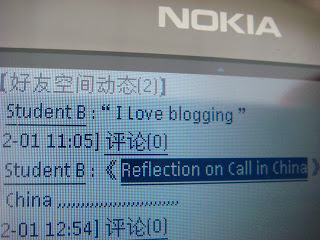In practice, college students in my working context are more interested in the WAP mobile learning, especially the QQ blogging mode. Students are strongly motivated when instructor comments their QQ blogs. Some students even commented my QQ blog when attending class. It’s quite inspiring for teachers to do something.
My approach regards WAP technology as supported, and English study as the research object, have developed the English study platform under the environment on the basis of WAP mobile learning.
Let’s see whether it works to construct a WAP mobile learning environment.
Take Nokia E-71 as example
Chose connectivity to connect the Mobile Internet (WAP)
Log in QQ blog (the most common and popular blog among students) powered by TENCENT (0700.HK)
The Dashboard of QQ blog (Assuming you are Student A)
Ok, let’s try the functions of QQ blog.
Task 1
Adding friends
*Click on Friend’s list
*Type in her/his ID
* Search
*Add your friend student B in search result
Task 2
New post
*Click on New post on Dashboard
*Write the title and the content
*Add picture if needed
*Add QQ Emoticon if needed(quite popular)
*Submit
Task 3
Commenting
*Click on Updates of friends in Dashboard
*Click on the second post of student B
*Type in “I can’t agree with you” as comment,
*Submit
Viewing updates of own blog
*Click on Blog archive in dashboard
*View the visit times and comment times
*Click on the post “Reflection on the reading”
*View the comment by student B
*Reply to the comment
Task 5
Locating the visitor
*Click on friends’ list in dashboard
*Locating
QQ blog Vs Blogger (tested)
Time to log in
QQ blog : 38 seconds
Blogger: 35 seconds
Time to a add a friend:
QQ blog: 28 seoncds
Blogger: 30 seconds
The disadvantages of QQ blog lie in its language option, video and audio functions, and the recognition of using cell phone in class. But I’m personally optimistic toward the rapid development of 3G and Andriod platform. That’s why Tencent (0070 HK) is worthy of 148.70 HK dollar and China Mobile (0941 HK) 75.70 HK dollar in HK stock market.
Teaching implications
Post the course materials in instructor’s blog
*Have students work in groups of 4 or 5 and connect to instructor’s blog by Wap
*Group members work together to figure out the concepts of these terms.
*Use Google in Wap.google.com if needed
*Then have students discuss the question “Are any of these forms of communication more important than the others?” Each group should choose one as the most important.
*Encourage different groups to share their views and evaluate others' views by using qq.
*Each group picks one to generalize group views in class
Home work: students reflect on the CMC and Emerging technologies they learnt by posting on their own blog.
















Okay, this answers some of my questions in your next post (sorry for reading these in the wrong order!). I am still wondering what the aims of these activities are though: any thoughts?
ReplyDeleteI’m teaching English majors in a Normal college. Most of my students are would-be teachers in secondary school. Every time attending the course “New Technologies in LT”, enjoying the latest development of technology in LT, I was thinking, thinking and rethinking.
ReplyDelete“How can I apply the technology to benefit the language learning of my students?How can I help them to use technology to benefit their students in their future career?”
What I’m learning in this course is what I’m going to teach directly in my working place without the need of much adaption for we have similar teaching aims “teach students a variety of approaches to the use of new technology in language teaching”
That’s why I compared QQ blog and Blogger for I also like my students to do the same thing in blog
The problems are, students do not have access to computer (both in class and off class), and instructors do not have access to computer and projector in class (except Listening course).
Should I give them up, should I give myself up or should they give themselves up the use of technology when facing the status quo? No, technology begins at hand. That is why I’d like to call it action research. It addresses the primary needs of my students “the need of using technology in a convenient and affordable way”.
I think it will tremendously benefit tertiary students and instructors as well when computer and internet accesses are unattainable and where wap 2.0 and mobile phones are integrate into students’ daily life.
For some people, technology is taken as a means to an end. For many others, technology is itself an end that has been searching for by many means. If they lose the end at the first place, they lose means to reach many other ends.
That’s what I was and will be anxious about.